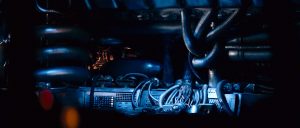The Inhuman Violence of Capitalism in Alien
Josh Martin

“You’ll get whatever’s coming to you.” Hidden in shadows, Ellen Ripley (Sigourney Weaver), the only eventual survivor of the Nostromo’s crew, predicts the fate of her colleagues.
From the moment the crew of the Nostromo awakens from their collective slumber, Ridley Scott’s Alien (1979) foregrounds the economic concerns of these interstellar laborers. In fact, this dimension is part of the very fabric of the film, stretching from Parker (Yaphet Kotto) and Brett’s (Harry Dean Stanton) request for full shares to the corporation’s command for the priority pursuit and return of the creature. But through an analysis of Scott’s approach to the mise-en-scène and the numerous implications of this economic dynamic, an even more disturbing undercurrent emerges as a fundamental aspect of the film’s subtext. In this manner, the terrifying alien creature and the artificially intelligent systems on board the Nostromo serve not just as assets for industrialist impulses, but as substitutions for the corporation, replacing a distinctly human capacity for cruelty with the emptiness of mechanical and monstrous entities. Through this series of symbolic substitutions, Alien plays on notions of fate and chance, shifting the layers of fear so often found in the horror genre to a terror rooted in the absence of basic human emotion in the unthinking servants of an exploitative, nearly anonymous company.
Well before the arrival of the alien creature, the early interactions between Ellen Ripley (Sigourney Weaver), Parker and Brett suggest the intersection of economic reality and a conceptualization of pre-determined fate. After the corporation re-routes the Nostromo for a purpose unknown to the crew at the time, Parker and Brett continue their quest for a full share of wages. As Brett lights a cigarette with a blowtorch in the icky underbelly of the ship, Parker presses Ripley on the idea of more money in an attempt at deliberate annoyance. In response, she mockingly says, “Don’t worry, Parker, yeah, you’ll get whatever’s coming to you.” Obscured by hazy steam and film noir-like shadows that create a pattern on her face, Ripley dismisses her colleagues at the end of the conversation, which becomes confusing as the noise of the ship’s industrial milieu grows more oppressive. On the surface, there’s nothing inherently remarkable about this interaction; Scott shoots the conversation in shot/reverse shot, using shadows and ambient industrial sounds that are repeated throughout the rest of the film. But the specificity of Ripley’s statement and the negative connotation of the phrase “get whatever’s coming to you” indicates some foresight on behalf of the character, one that’s confirmed by her survival and Parker’s eventual death in their fight against the alien creature. Even the visual frame of this scene suggests Ripley’s privileged position of knowledge, placing her alone, drenched in darkness, muddling her words in a way that evades Parker and Brett’s understanding. Though it isn’t intended as a threat, Ripley’s throwaway quip serves as the ominous collision of a futile attempt at economic equality and the acknowledgement of exploitation fated to end in violence.
To expand on this scene, the notion of eventually receiving “whatever’s coming to you” implies total unpredictability, a sense that these characters will be submitted to a destiny based firmly on a fate that is preordained and unknowable. It is here that the film introduces the key motif of chance, something referred to time and time again as the hunt for the alien creature progresses. As scientists and workers (and in one case, an android), the crew members of the Nostromo are obsessed with numbers. Parker and Brett are concerned with the exact dollar sign on their paychecks, which is reflected back in the corporation’s desire to retrieve an asset with a specific monetary value. But as the film progresses, the characters are increasingly preoccupied with putting numerical designations on their chance of survival. When he hatches a plan to trap the alien in the air duct, Captain Dallas (Tom Skerritt) returns to the secure space of the ship’s headquarters, where the bulk of the data collected by Mother is stored. As Jerry Goldsmith’s quietly unnerving score hums in the background, Dallas asks Mother several questions, all of which are received with a thud. Lulled into a fearful honesty by the nurturing, almost symbolically womb-like environment of the main database, Dallas finally types, “What are my chances?” Once again, it’s a question that Mother, in all her/its sentient power, cannot — or will not — answer. This motif has a final echo in the moments immediately after Ash (Ian Holm) is revealed as an android and decapitated by Ripley and Parker, who subsequently reignite his bleeding corpse for one final interrogation. As Scott captures Ash’s final monologue in uncomfortable close-ups on his fluid-stained face, the android builds to the eerie, disaffected delivery of one final line: “I can’t lie to you about your chances, but you have my sympathies.”

The inhuman body of robotic android Ash (Ian Holm) becomes a medium for the corporation to communicate the crew’s predetermined fate.
The presence of robotic, emotionless, task-driven forces like Ash and Mother creates the sense that Ripley and the remaining crew members are actively working against the will of the corporation; rather than methodically outsmarting the alien, they are forced to reckon with low chances and a desperate attempt at survival. With its tension between pristine, almost heavenly white colors and a grungy tangle of cords and pipes, the ship itself is virtually a character in the film. It is also the most abundantly obvious symbol of economic necessity in Alien, a vessel designed with the goal of producing goods and capital. As the narrative develops, the viewer is forced to wonder if the ship is working with the crew or solely servicing the aims of the corporation. This may not really be a question at all, as it’s quickly suggested that the ship is one of many elements incidentally assisting the creature. The collaboration is not deliberate, but it is suggested by the ship’s geography, by the way its cords and sounds and proliferation of smoke enable the obfuscation of a violent entity. In this regard, the most notable scene comes near the end of the film, when Ripley and Jonesy (the film’s perceptive cat) have seemingly escaped the alien on a secondary craft. The scene is patient and careful in its execution; with a minimal use of music and sound, Scott shows Ripley undressing and meticulously preparing for a long night in the pod. The observant viewer immediately notes something strange — the head of the alien, obscured between the tangled pipes of the pod’s wall, whose architecture resemble the slimy, monochromatic shape of the alien. Allowing the unsettling silence to percolate for a moment, Scott lingers on a shot of Ripley before the alien quickly outstretches its hand, prompting a rapid cut to a close-up on a passionate scream from Ripley and an ominous musical swell. In the context of the film, this scene serves primarily as a jolt-inducing jump scare, but it also reaffirms a symbiotic relationship between the creature and its surroundings. Though it is merely following its own animalistic instincts, the alien is consistently assisted by the deliberate choices of the corporation and the geography of the Nostromo.

The alien hides among the wires of the escape pod, blended in with the tangled geography of the corporation’s vessel.
The ambiguity of the corporation’s motives makes it difficult to understand why they appear to be enabling the alien, but there are numerous moments throughout the film that allow the viewer to comprehend its ultimate goals. Ripley’s declaration that the corporation wishes to weaponize the creature is the most crucial statement, primarily because of what it implies about the relationship between the alien creature and the corporate structure allowing it to pursue its natural impulses. The creature, with its vicious spewing of acid and its rows of razor sharp teeth, is unquestionably a fearsome and exploitative force on the ship; after all, it is responsible for the death of every crew member with the exception of Ripley. But if Ripley’s suggestion that the corporation is planning to use the alien creature as a weapon is indeed correct, then the alien is also exploited for its abilities, used by the company in the pursuit of a sizable profit. Therefore, the figure of the alien is both a violent force and a potential victim; much like the crew, it is a pawn in a bigger game. Since there are no on-screen representatives of the corporation in the film, the will of this monolithic beacon of capital is carried out by forces that are robotic, animalistic, or perhaps a hybrid of the two. In the case of both Ash and the creature, the cold, clinical, and virtually uncontrollable attributes that are viewed as desirable by the corporation are exploited in the pursuit of loftier goals. In the process, the malevolent forces of robotic precision and uncontrollable violence become representative emblems of industrial capitalism’s idealized version of itself, where cruelty and expendability are ruthlessly carried out by beings without a moral or emotional compass. With the threat of violence looming from forces of inhuman rationality and drive, Alien finds a source of fear in the idea of facing something that is decidedly inhuman. In her essay on the film’s portrayal of monstrosity and femininity, Barbara Creed emphasizes that “the confrontation with death, as represented in the horror film, gives rise to a terror of self-disintegration, of losing one’s self or ego” (136). In Alien, the terror of losing one’s sense of self is further enhanced by its presentation of alternate versions of the self, of variant forms of motivation and consciousness that are inhuman in form and substance.
From the faceless corporate villains to the representation of the film’s tangible antagonists, this fear of easily hidden, emotionless entities eventually coincides with Alien’s emphasis on the bodily destruction of its characters. In his broad assessment of the horror film, Stephen Prince notes that “[g]raphic imagery of dismemberment… challenges belief in the integrity of the body,” eventually claiming that “if the body can be so easily and disgustingly destroyed, then so too can the self” (387). The characters in Alien face almost certain death by vicious bodily destruction, but before they can be eliminated, they’re forced to confront ruthless agents of an economic powerwho have arguably never possessed a sense of self at all. In this fashion, Alien’s horror comes from the viewer’s participation in a game driven by forces that are incapable of viewing human life as anything but disposable, where mathematical chances are incalculable and each and every character is fatally destined to “get whatever’s coming” to them. In the case of Ripley, what’s coming is survival. Others aren’t so lucky.
Works Cited
Creed, Barbara. “Alien and the Monstrous-Feminine.” Repressions, pp. 128-141. Accessed 22 Feb. 2019.
Prince, Stephen. “The Horror Film.” An Introduction to Film Genres, W.W. Norton & Company, 2014, pp. 369-405.
Works Consulted
Knight, Jacob. “Alien (1979).” Letterboxd, 19 April 2017, https://letterboxd.com/jacobknight/film/alien/. Accessed 22 Feb. 2019.

